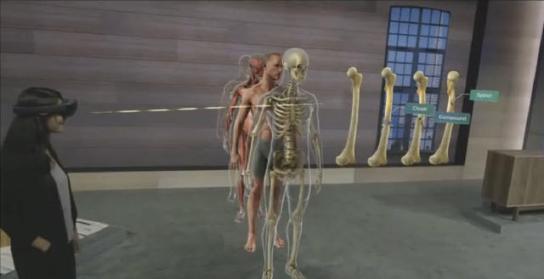Revolutionizing Education: Microsoft Unveils HoloLens Educational Capabilities in Compelling New Video

Introduction:
In the realm of technology-driven education, Microsoft’s HoloLens has emerged as a groundbreaking tool, redefining the possibilities of immersive and interactive learning experiences. In a recently released video, Microsoft provides a captivating glimpse into the educational capabilities of HoloLens, showcasing its potential to transform traditional classrooms into dynamic, holographic environments. This article takes an in-depth look at Microsoft’s latest foray into educational technology, exploring the features, applications, and implications of HoloLens in shaping the future of learning.
The Power of HoloLens in Education:
Microsoft’s HoloLens, a mixed reality headset, has garnered attention for its ability to overlay digital holograms onto the real world, creating an augmented reality (AR) experience. This unique capability has found its way into various industries, and the educational sector stands out as a domain where HoloLens can revolutionize the learning landscape.
The recently released video from Microsoft delves into several key areas where HoloLens is making a significant impact on education. Let’s explore these aspects in detail:
- Virtual Field Trips:
- One of the most compelling features showcased in the video is the use of HoloLens to facilitate virtual field trips. Students can transcend the confines of the classroom and be transported to historical landmarks, scientific marvels, or distant geographical locations—all through the immersive power of holographic visuals. This not only enhances geographical knowledge but also provides a multisensory experience that traditional textbooks cannot replicate.
- Interactive Learning Modules:
- HoloLens enables the creation of interactive 3D models that can be seamlessly integrated into educational modules. For example, students studying anatomy can dissect virtual organisms, manipulate complex molecular structures, or explore the inner workings of the human body—all in a three-dimensional, interactive space. This hands-on approach to learning fosters deeper understanding and retention of complex subjects.
- Collaborative Learning Environments:
- The video showcases the collaborative potential of HoloLens in education. Students wearing HoloLens headsets can see and interact with shared holographic content in real time. This collaborative environment transcends physical boundaries, allowing students from different locations to engage in group projects, simulations, or discussions as if they were in the same room.
- Enhanced Classroom Presentations:
- Teachers equipped with HoloLens can elevate traditional lectures by incorporating holographic elements into their presentations. Concepts that are challenging to convey using traditional methods can be brought to life through holographic visuals. Whether explaining complex mathematical theorems, historical events, or scientific principles, teachers can make learning more engaging and accessible.
- Immersive Language Learning:
- HoloLens opens new possibilities for language education by immersing students in realistic scenarios. Language learners can interact with holographic characters, practice real-world conversations, and enhance their language skills in a dynamic and culturally rich environment. This approach goes beyond traditional language learning methods, offering an immersive experience that accelerates proficiency.
Applications Across Educational Levels:
Microsoft’s HoloLens video emphasizes the versatility of this technology across various educational levels, from elementary schools to higher education institutions. The adaptability of HoloLens allows educators to tailor experiences to meet the specific needs and developmental stages of students. Here’s a breakdown of its applications:
- Elementary and Middle Schools:
- In primary and middle school settings, HoloLens can bring abstract concepts to life through engaging visualizations. Whether it’s exploring the solar system, understanding basic physics, or embarking on virtual adventures, young learners can benefit from immersive experiences that cater to their natural curiosity.
- High Schools:
- At the high school level, HoloLens can be integrated into STEM (science, technology, engineering, and mathematics) curricula to provide hands-on experiences in subjects like biology, chemistry, physics, and computer science. Virtual dissections, architectural simulations, and programming exercises become more tangible and memorable.
- Higher Education Institutions:
- In colleges and universities, HoloLens offers advanced applications for specialized fields of study. Medical students can engage in virtual surgeries, engineering students can simulate complex design projects, and art students can explore three-dimensional canvases. The technology provides a bridge between theoretical knowledge and practical application.
Overcoming Challenges in Implementation:
While the potential of HoloLens in education is immense, its successful integration into classrooms requires addressing various challenges. These challenges include:
- Cost and Accessibility:
- HoloLens devices come with a significant price tag, which may pose challenges for widespread adoption in educational institutions with budget constraints. Ensuring equitable access to this technology for all students remains a key consideration.
- Technical Infrastructure:
- Implementing HoloLens effectively requires robust technical infrastructure, including high-speed internet connectivity, compatible devices, and optimized software applications. Educational institutions need to invest in these elements to harness the full potential of mixed reality experiences.
- Training for Educators:
- Educators play a pivotal role in leveraging HoloLens for effective teaching. Providing comprehensive training programs for teachers is crucial to ensure they can confidently integrate mixed reality experiences into their lesson plans and maximize the benefits of the technology.
- Content Development:
- Developing high-quality holographic content aligned with educational standards is essential. Collaboration between educators, content developers, and technology experts is necessary to create a diverse range of immersive learning materials that cater to different subjects and age groups.
Conclusion:
Microsoft’s latest video showcasing HoloLens educational capabilities provides a glimpse into a future where classrooms are transformed into dynamic, holographic environments. The technology’s potential to enhance engagement, understanding, and collaboration in education is evident. As HoloLens continues to evolve, addressing challenges and garnering broader accessibility, it has the potential to redefine the way students learn and educators teach. The journey towards a more immersive and interactive educational landscape fueled by mixed reality experiences is underway, and Microsoft’s HoloLens stands at the forefront of this transformative shift.




